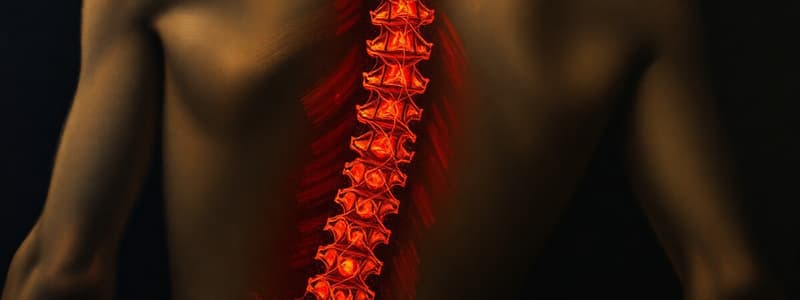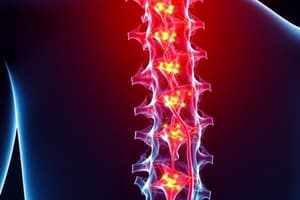Podcast
Questions and Answers
What is the primary action of the infraspinatus muscle?
What is the primary action of the infraspinatus muscle?
- Internal rotation of the shoulder
- Flexion of the elbow
- Abduction of the arm
- External rotation of the shoulder (correct)
Which nerve innervates the supraspinatus muscle?
Which nerve innervates the supraspinatus muscle?
- Suprascapular nerve (correct)
- Axillary nerve
- Subscapular nerve
- Thoracodorsal nerve
Where does the teres minor muscle insert?
Where does the teres minor muscle insert?
- Superior facet of the greater tubercle of humerus
- Lesser tubercle of humerus
- Inferior facet of the greater tubercle of humerus (correct)
- Middle facet of the greater tubercle of humerus
What is the origin of the subscapularis muscle?
What is the origin of the subscapularis muscle?
Which of the following muscles is NOT part of the rotator cuff?
Which of the following muscles is NOT part of the rotator cuff?
What is the primary effect of damage to specific cervical spinal nerves on muscle function?
What is the primary effect of damage to specific cervical spinal nerves on muscle function?
How does pelvic tilt affect the alignment of the spine?
How does pelvic tilt affect the alignment of the spine?
What role do ligaments play in the movement of the shoulder girdle?
What role do ligaments play in the movement of the shoulder girdle?
What occurs if there is damage to the quadrangular space?
What occurs if there is damage to the quadrangular space?
What is the primary function of the cerebellum in relation to balance?
What is the primary function of the cerebellum in relation to balance?
Which of the following describes the orientation of the scapula?
Which of the following describes the orientation of the scapula?
Which muscle is primarily innervated by the Thoracodorsal nerve?
Which muscle is primarily innervated by the Thoracodorsal nerve?
What is the result of a resisted movement causing pain?
What is the result of a resisted movement causing pain?
Which muscles contribute to scapulothoracic upward rotation?
Which muscles contribute to scapulothoracic upward rotation?
Which action is performed by the Teres Major?
Which action is performed by the Teres Major?
What is true about the Subscapularis muscle?
What is true about the Subscapularis muscle?
Which of the following nerves arises from the superior trunk of the brachial plexus?
Which of the following nerves arises from the superior trunk of the brachial plexus?
Which nerve is NOT a terminal branch of the brachial plexus?
Which nerve is NOT a terminal branch of the brachial plexus?
Which muscles induce the inferior slide of the humerus on the scapula?
Which muscles induce the inferior slide of the humerus on the scapula?
Which nerves arise from the roots of the brachial plexus?
Which nerves arise from the roots of the brachial plexus?
Which combination of actions does the Subscapularis perform?
Which combination of actions does the Subscapularis perform?
Which dermatomes correspond to the lateral forearm and thumb?
Which dermatomes correspond to the lateral forearm and thumb?
What is the primary action of the myotome C7?
What is the primary action of the myotome C7?
What is the ratio of movement between the glenohumeral joint and the scapulothoracic joint during shoulder abduction?
What is the ratio of movement between the glenohumeral joint and the scapulothoracic joint during shoulder abduction?
Which artery branches directly from the subclavian artery?
Which artery branches directly from the subclavian artery?
What does the scapulohumeral rhythm prevent during shoulder movements?
What does the scapulohumeral rhythm prevent during shoulder movements?
Which myotome is responsible for finger flexion?
Which myotome is responsible for finger flexion?
What is the greatest amount of scapular rotation observed during shoulder abduction?
What is the greatest amount of scapular rotation observed during shoulder abduction?
Which of the following actions is NOT primarily associated with myotome C6?
Which of the following actions is NOT primarily associated with myotome C6?
Which of the following muscles is primarily responsible for elevating the scapula?
Which of the following muscles is primarily responsible for elevating the scapula?
Which muscle acts as a downward rotator of the scapula?
Which muscle acts as a downward rotator of the scapula?
Which of the following muscles is NOT involved in retracting the scapula?
Which of the following muscles is NOT involved in retracting the scapula?
Which muscle is involved in both shoulder abduction and flexion?
Which muscle is involved in both shoulder abduction and flexion?
Which muscles are primarily responsible for the upward rotation of the scapula?
Which muscles are primarily responsible for the upward rotation of the scapula?
Which muscle is primarily responsible for internal rotation of the shoulder?
Which muscle is primarily responsible for internal rotation of the shoulder?
Which of these muscles contributes to abduction at the glenohumeral joint?
Which of these muscles contributes to abduction at the glenohumeral joint?
Which muscle group is known for causing external (lateral) rotation of the shoulder?
Which muscle group is known for causing external (lateral) rotation of the shoulder?
Which muscle primarily assists with the extension and adduction of the shoulder?
Which muscle primarily assists with the extension and adduction of the shoulder?
Which combination of muscles is typically involved in the stabilization of the glenohumeral joint?
Which combination of muscles is typically involved in the stabilization of the glenohumeral joint?
Flashcards are hidden until you start studying
Study Notes
Damage to Spinal Nerves
- Damage to a cervical nerve root can impact specific muscles and posture, based on the level of the nerve.
- For example, damage to the C5 nerve root can affect the deltoid muscle (shoulder abduction) and the biceps brachii muscle (elbow flexion).
Spine Movement and Effects
- Flexion, extension, lateral bending, and rotation of the spine involve ligaments, muscles, the intervertebral foramen, discs, and facet joints.
- Specific movements can compress or stretch these structures.
- Pelvic tilt affects spinal alignment and can influence the pressure on intervertebral discs.
Deep Back Muscles
- Deep back muscles stabilize the spine and control movement.
- Muscle location influences the moment arm, which affects force production for specific movements.
Arthrokinematics
- Arthrokinematics describes the movements of joint surfaces.
- Understand cervical and lumbar flexion, extension, lateral bending, and rotation.
- Learn how joint surfaces move during these motions.
Suboccipital Area
- The suboccipital region contains muscles, nerves, ligaments, and blood vessels related to the head and neck.
- Arthrokinematics of the occiput and C1 (atlas) involve specific movements for head rotation and flexion.
Sternoclavicular Joint
- Sternoclavicular joint arthrokinematics involve movements of the clavicle and scapula.
- Scapular movements include protraction, retraction, elevation, depression, upward and downward rotation.
- Analyze the relationship between clavicular and scapular movements.
Glenohumeral Joint
- Glenohumeral joint arthrokinematics involve movements of the humerus relative to the glenoid fossa.
- Identify the axis of rotation for the glenohumeral joint.
- Ligaments control the movement and stability of the shoulder.
- Understand the role of various ligaments, like the coracoacromial ligament, in shoulder function.
Force Couples
- Force couples involve the combined action of multiple muscles to produce a specific movement.
- For example, the upper and lower trapezius, serratus anterior muscles work together for upward rotation of the scapula.
Spinal Arteries
- Understand the path and branching of spinal arteries, supplying the spinal cord.
- Know the arteries supplying the upper extremity.
Shoulder Injury Implications
- Damage to nerves, impacts specific muscles and movements, such as deltoid weakness for shoulder abduction.
- Analyze the consequences of damage to different anatomical spaces, like the quadrangular space and the triangular space.
Pain and Tenderness
- Pain with resisted movements can indicate muscle injury, e.g., pain during resisted shoulder abduction may point to a supraspinatus injury.
- Tenderness on palpation of a specific area can suggest involvement of certain muscle groups, e.g., tenderness over the infraspinatus muscle.
Neuro-Sensory System for Balance
- The neuro-sensory system plays a vital role in balance.
- Integrate the roles of different brain areas like the cerebellum and basal ganglia in balance control.
Scapular Orientation
- The scapula is oriented 30-40 degrees anteriorly to the frontal plane.
- This orientation is crucial for understanding its movement and its role in shoulder function.
Axio-Appendicular Muscles
- Axio-Appendicular Muscles connect the axial skeleton to the appendicular skeleton.
- These muscles include the trapezius, latissimus dorsi, and others.
- Know their innervation and actions.
Muscle Action Determination
- Understanding muscle origin, insertion, and fiber direction, considering joint movement, helps determine muscle action.
Rotator Cuff Muscles
- The rotator cuff muscles are crucial for shoulder stability and movement.
- Know their attachment, action, and innervation.
Scapulothoracic Joint Muscles
- Muscles acting on the scapulothoracic joint control scapular motion.
- Identify the elevators, depressors, protractors, retractors, upward, and downward rotators.
Glenohumeral Joint Muscles
- Glenohumeral joint muscles control humerus movement.
- Identify muscles responsible for abduction, adduction, flexion, extension, internal, and external rotation.
- Know the contribution of both glenohumeral and scapulothoracic muscles for specific motions.
Force Couples
- Understand the paired muscles that work together to create a movement. For example, the supraspinatus and middle deltoid act as force couples for abduction.
Teres Major and Rotator Cuff
- Teres major is not a rotator cuff muscle.
- It adducts and medially rotates the arm, similar to subscapularis.
Inferior and Superior Humerus Movements
- Three out of four rotator cuff muscles contribute to the inferior slide of the humerus on the scapula during abduction.
- Muscles that assist with the superior rolling of the humerus on the glenoid during abduction.
Brachial Plexus Nerves
- Understand the origins of nerves from the superior trunk, roots, and cords of the brachial plexus.
- Know the branches of the brachial plexus.
Dermatomes & Myotomes
- Review the dermatomes and myotomes of the upper limb.
- Dermatomes represent the cutaneous distribution of a spinal nerve.
- Myotomes represent the muscular innervation of a spinal nerve.
Upper Extremity Vasculature
- Familiarize yourself with the major arteries supplying the upper extremity, from the subclavian artery to the axillary artery.
- Understand the branches of these arteries and their distribution.
Scapulohumeral Rhythm
- Scapulohumeral rhythm describes the coordinated movement of the scapula and humerus during shoulder abduction.
- A 2:1 ratio exists, with 2 degrees of humeral movement for every 3 degrees of total abduction.
- The scapula contributes to the upward rotation, maximizing shoulder range of motion.
Scapulohumeral Rhythm Function
- Understand the importance of scapulohumeral rhythm for smooth, coordinated arm movement, preventing impingement, and promoting shoulder stability.
Glenohumeral Joint Arthrokinematics
- Arthrokinematics of the glenohumeral joint involve movements of the humeral head relative to the glenoid fossa.
- Describe how these joint surfaces move during various shoulder motions.
Studying That Suits You
Use AI to generate personalized quizzes and flashcards to suit your learning preferences.




